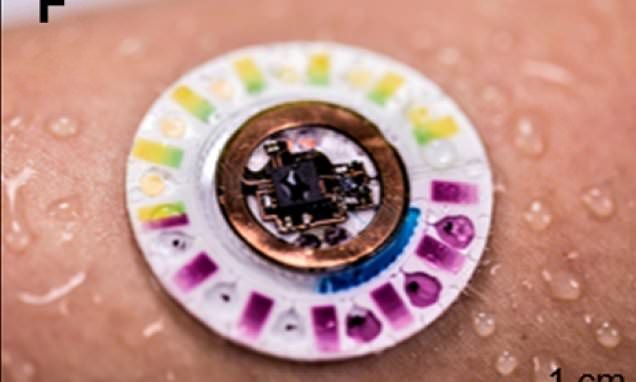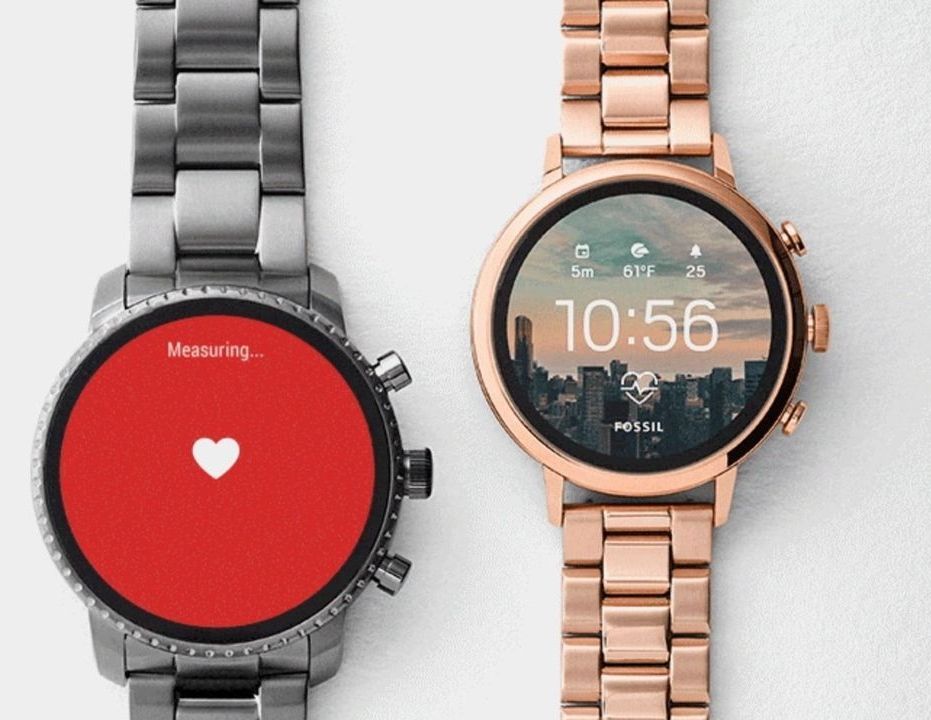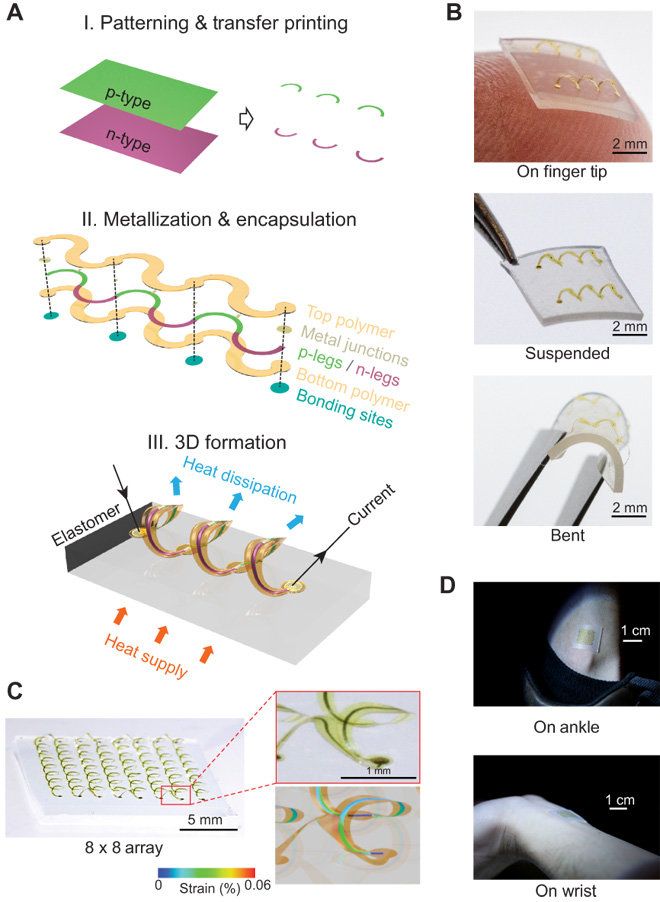Device made from flexible, inexpensive materials could power large-area electronics, wearables, medical devices, and more.


ASU Smartwatch is not only a wearable gadget, but a projection puts the “screen” on back of the hand, walls, or desktop etc.

A new wearable patch can monitor your health through your sweat.
Fitness and health trackers are everywhere, but most of them are limited to collecting data on your heartbeat, how much your moving and information you manually input to their paired apps.
That’s helpful if you’re trying to get in shape, but for people suffering from chronic conditions and diseases — like kidney disease or cystic fibrosis — more exact and frequent analyses could alert them to life-endangering changes.

While the company is no doubt losing quality employees, Fossil is still committed to wearable tech.
Rumors about a Pixel Watch have abounded for years. Such a device would certainly make sense as Google attempts to prove the viability of its struggling wearable operating system, Wear OSeems the company is finally getting serious about the prospect. Today Fossil announced plans to sell its smartwatch IP to the software giant for $40 million.
Sounds like Google will be getting a nice head start here as well. The deal pertains to “a smartwatch technology currently under development” and involves the transfer of a number of Fossil employees to team Google.
“Wearables, built for wellness, simplicity, personalization and helpfulness, have the opportunity to improve lives by bringing users the information and insights they need quickly, at a glance,” Wear OS VP Stacey Burr said in a statement. “The addition of Fossil Group’s technology and team to Google demonstrates our commitment to the wearables industry by enabling a diverse portfolio of smartwatches and supporting the ever-evolving needs of the vitality-seeking, on-the-go consumer.”
Innovation in fashion is sparking radical change. In the future clothes could be computers, made with materials designed and grown in a lab.
Click here to subscribe to The Economist on YouTube: https://econ.st/2xvTKdy
A new wave of innovation is fueling a radical change in fashion. Wearable technology, data, automation and lab-grown materials will have a major impact on what people will be wearing in the future.
Since the birth of sewing and weaving, technology has always led developments in fashion. The Industrial Revolution mechanized manufacturing enabling mass production. In the 1960s synthetic materials like polyester took off, creating new possibilities for fashion.
Now the convergence of new technologies is opening up previously unimaginable possibilities. Self-styled fashion scientist Dr Amanda Parkes is in the vanguard of the industry’s latest reinvention. She heads up innovation at FT labs, a venture capital firm that invests primarily in disruptive fashion tech startups. Among these startups the race is on to find the next generation of renewable materials that can be grown in a lab. Traditional silk is produced from insect larvae that form cocoons, most commonly silkworms. But rather than relying on these insects bolt threads is creating silk in test tubes. Bio fabricated materials remove the need for animals and insects and they are a more sustainable and efficient way of producing raw materials.
Other companies are creating leather alternatives. Rather than using animals scientists are creating bio fabricated materials from pineapple leaves and even mushrooms. The convergence of fashion and technology also provides opportunities to transform not just clothes but the people wearing them.
Power suits, robotaxis, Leonardo da Vinci mania—just a few of the things to look out for in 2019. But what else will make our top ten stories for the year ahead?
Click here to subscribe to The Economist on YouTube: https://econ.st/2xvTKdy
What will be the biggest stories of the year ahead?
00:35 — 10 — Powered Clothing.
In 2019 power dressing will take on a whole new meaning when this strange-looking clothing hits the market. Not so much high fashion as high tech, it’s a suit with built-in power that will literally get people moving. Part of the wearable robotics revolution, the suit is made up of battery-powered muscle packs which contract just like a human muscle to boost the wearer’s strength. With the global population of over 60s expected to more than double by 2050, and retirement age increasing, there’s no shortage of potential markets. But don’t expect the suits to ease the burden on aching limbs and overstretched health services anytime soon — as these suits don’t come cheap. According to the manufacturer they’ll retail for around the cost of a bespoke tailored suit.
02:13 — 9 — The year of cheap flights.
2019 will be the year low-cost long-haul travel takes off. You’ll be able to buy a ten thousand mile flight from London to Sydney for around $350 and this is why. The world will boast two new state-of-the-art mega hub airports and competition between them will drive down the cost of flying. Daxing Airport outside Beijing is due to open in 2019 and will feed growing demand for air travel in China. Beijing already has one of the world’s biggest airports and for China this new mega hub will send an important message to the world. Rivaling Daxing as a national symbol of global prestige will be a new mega hub airport in Istanbul. Opened in 2018 it covers a staggering 26 square miles — an area larger than the island of Manhattan. And in 2019 consumers will again be the beneficiaries of a state sponsored economic push. But the low fares offered by competition between these hubs could be short-lived.
04:06 — 8 Stonewall riots at 50.
What if you could store your memories in a digital bank? Neo Mohsenvand from MIT Media Lab is experimenting with the science behind memories and emotion by using wearable tech.
Lightweight, soft, wearable robots that people can wear all day, every day, to help them regain use of their upper extremities.
This wearable strap for your fingers allows you to text on your phone wirelessly 🖐️.

Miniaturized semiconductor devices with energy harvesting features have paved the way to wearable technologies and sensors. Although thermoelectric systems have attractive features in this context, the ability to maintain large temperature differences across device terminals remains increasingly difficult to achieve with accelerated trends in device miniaturization. As a result, a group of scientists in applied sciences and engineering has developed and demonstrated a proposal on an architectural solution to the problem in which engineered thin-film active materials are integrated into flexible three-dimensional (3D) forms.
The approach enabled efficient thermal impedance matching, and multiplied heat flow through the harvester to increase efficient power conversion. In the study conducted by Kewang Nan and colleagues, interconnected arrays of 3D thermoelectric coils were built with microscale ribbons of the active material monocrystalline silicon to demonstrate the proposed concepts. Quantitative measurements and simulations were conducted thereafter to establish the basic operating principles and key design features of the strategy. The results, now published on Science Advances, suggested a scalable strategy to deploy hard thermoelectric thin-films within energy harvesters that can efficiently integrate with soft material systems including human tissue to develop wearable sensors in the future.
Thermoelectric devices provide a platform to incorporate ubiquitous thermal gradients that generate electrical power. To operate wearable sensors or the “Internet of Things” devices, the temperature gradient between the surrounding environment and the human body/inanimate objects should provide small-scale power supplies. Continued advances in the field focus on aggressive downscaling of power requirements for miniaturized systems to enhance their potential in thermoelectric and energy harvesting applications. Integrated processors and radio transmitters for example can operate with power in the range of subnanowatts, some recent examples are driven via ambient light-based energy harvesting and endocochlear potential. Such platforms can be paired with sensors with similar power to enable distributed, continuous and remote environmental/biochemical monitoring.